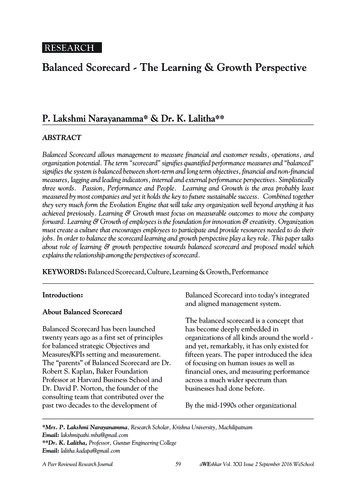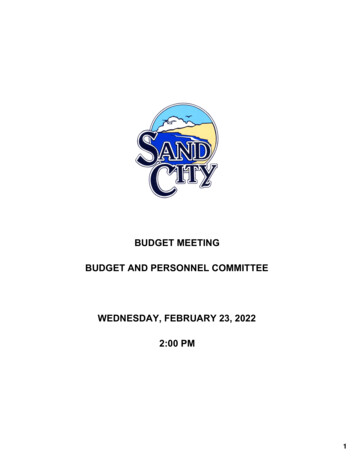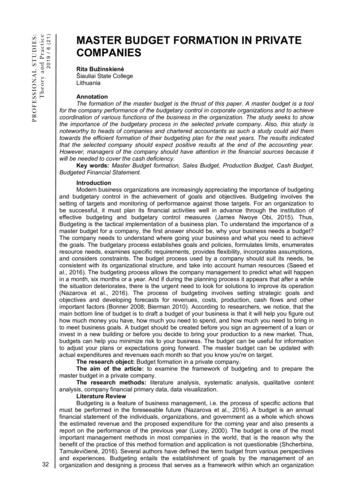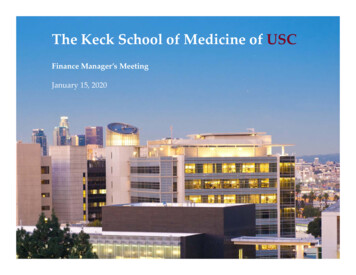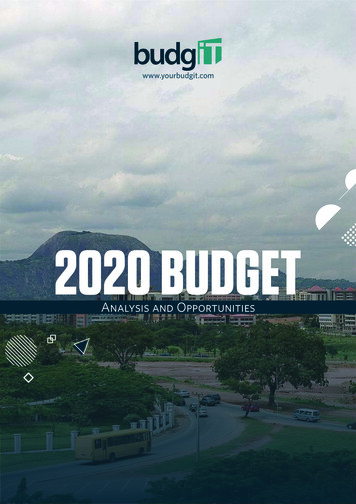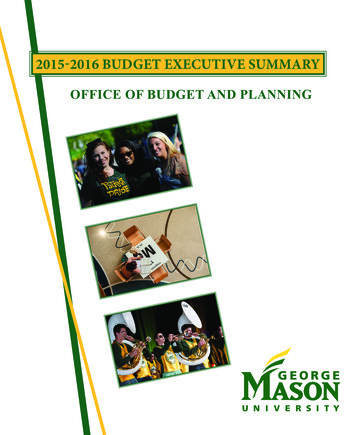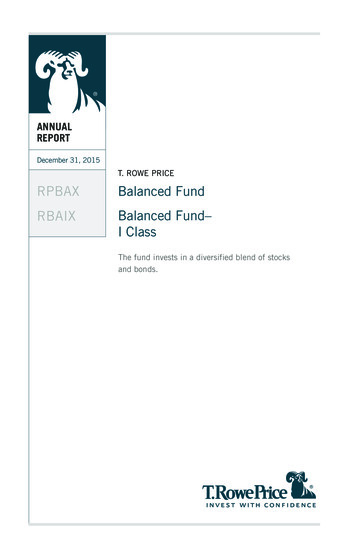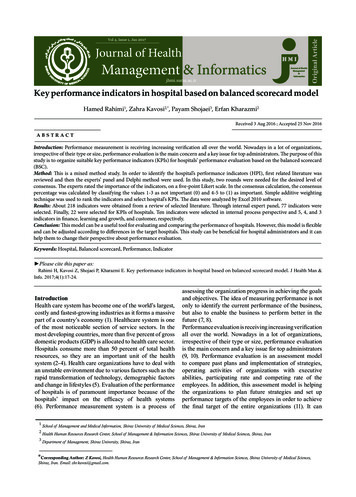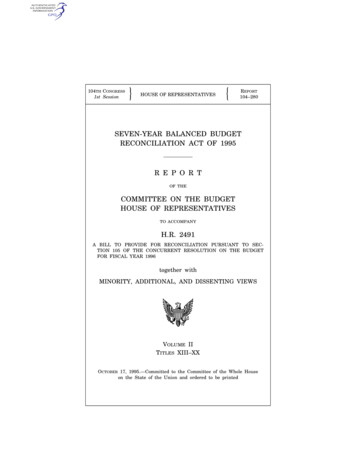
Transcription
104TH CONGRESS"1st SessionHOUSE OF REPRESENTATIVES!REPORT104–280SEVEN-YEAR BALANCED BUDGETRECONCILIATION ACT OF 1995R E P O R TOF THECOMMITTEE ON THE BUDGETHOUSE OF REPRESENTATIVESTO ACCOMPANYH.R. 2491A BILL TO PROVIDE FOR RECONCILIATION PURSUANT TO SECTION 105 OF THE CONCURRENT RESOLUTION ON THE BUDGETFOR FISCAL YEAR 1996together withMINORITY, ADDITIONAL, AND DISSENTING VIEWSVOLUME IITITLES XIII–XXOCTOBER 17, 1995.—Committed to the Committee of the Whole Houseon the State of the Union and ordered to be printed
SEVEN -YEAR BALANCED BUDGET RECONCILIATION ACT OF 1995 —VOLUME II
1104TH CONGRESS"1st SessionHOUSE OF REPRESENTATIVES!REPORT104–280SEVEN-YEAR BALANCED BUDGETRECONCILIATION ACT OF 1995R E P O R TOF THECOMMITTEE ON THE BUDGETHOUSE OF REPRESENTATIVESTO ACCOMPANYH.R. 2491A BILL TO PROVIDE FOR RECONCILIATION PURSUANT TO SECTION 105 OF THE CONCURRENT RESOLUTION ON THE BUDGETFOR FISCAL YEAR 1996together withMINORITY, ADDITIONAL, AND DISSENTING VIEWSVOLUME IITITLES XIII–XXOCTOBER 17, 1995.—Committed to the Committee of the Whole Houseon the State of the Union and ordered to be printedU.S. GOVERNMENT PRINTING OFFICE20–206WASHINGTON:1995
20–206COMMITTEE ON THE BUDGETJOHN R. KASICH, Ohio, ChairmanDAVID L. HOBSON, OhioMARTIN OLAV SABO, Minnesota,ROBERT S. WALKER, Pennsylvania,Ranking Minority MemberVice ChairmanCHARLES W. STENHOLM, TexasJIM KOLBE, ArizonaLOUISE MCINTOSH SLAUGHTER,New YorkCHRISTOPHER SHAYS, ConnecticutMIKE PARKER, MississippiWALLY HERGER, CaliforniaWILLIAM J. COYNE, PennsylvaniaJIM BUNNING, KentuckyALAN B. MOLLOHAN, West VirginiaLAMAR S. SMITH, TexasJERRY F. COSTELLO, IllinoisWAYNE ALLARD, ColoradoHARRY JOHNSTON, FloridaDAN MILLER, FloridaPATSY T. MINK, HawaiiRICK LAZIO, New YorkBILL ORTON, UtahBOB FRANKS, New JerseyEARL POMEROY, North DakotaNICK SMITH, MichiganGLEN BROWDER, AlabamaBOB INGLIS, South CarolinaLYNN C. WOOLSEY, CaliforniaMARTIN R. HOKE, OhioJOHN W. OLVER, MassachusettsSUSAN MOLINARI, New YorkLUCILLE ROYBAL-ALLARD, CaliforniaJIM NUSSLE, IowaCARRIE P. MEEK, FloridaPETER HOEKSTRA, MichiganLYNN N. RIVERS, MichiganSTEVE LARGENT, OklahomaLLOYD DOGGETT, TexasSUE MYRICK, North CarolinaSAM BROWNBACK, KansasJOHN SHADEGG, ArizonaGEORGE P. RADANOVICH, CaliforniaCHARLES F. BASS, New HampshirePROFESSIONAL STAFFRICHARD E. MAY, Staff DirectorEILEEN M. BAUMGARTNER, Minority Staff Director(II)
VOLUME II CONTENTSLEGISLATIVE leXIII—Committee on Ways and Means—Revenue Reconciliation .XIV—Committee on Ways and Means—Tax Simplification .XV—Medicare .XVI—Transformation of the Medicaid Program .XVII—Department of Commerce Abolition .XVIII—Welfare Reform .XIX—Contract Tax Provisions .XX—Budget Process .265150150193233233233REPORT LANGUAGETitles XIII and XIV—Committee on Ways and Means .Title XIII—Revenue Reconciliation .Title XIV—Tax Simplification .Title XVI—Transformation of the Medicaid Program .Title XVII—Department of Commerce Abolition .Miscellaneous House Report Requirements .MINORITY, ADDITIONAL,AND235240377603743949DISSENTING VIEWSTitle II—Committee on Banking and Financial Services . 957Title III—Committee on Commerce . 959Title IV—Committee on Economic and Educational Opportunities . 975Title VII—Committee on the Judiciary . 985Title VIII—Committee on National Security . 987Title IX—Committee on Resources . 988Titles XIII and XIV—Committee on Ways and Means . 1000Committee on the Budget . 1018(III)
104TH CONGRESS" HOUSE OF REPRESENTATIVES1st Session!REPT. 104–280VOLUME IIPROVIDING FOR RECONCILIATION PURSUANT TO SECTION 105 OF THE CONCURRENT RESOLUTION ON THEBUDGET FOR FISCAL YEAR 1996OCTOBER 17, 1995.—Committed to the Committee of the Whole House on the Stateof the Union and ordered to be printedMr. KASICH, from the Committee on the Budget,submitted the followingR E P O R Ttogether withMINORITY, ADDITIONAL, AND DISSENTING VIEWS[To accompany H.R. 2491][Including cost estimate of the Congressional Budget Office]The Committee on the Budget, to whom reconciliation recommendations were submitted pursuant to section 105 of HouseConcurrent Resolution 67, the concurrent resolution on the budgetfor fiscal year 1996, having considered the same, report the billwithout recommendation.
2TITLE XIII—COMMITTEE ON WAYS ANDMEANS—REVENUE RECONCILIATIONSEC. 13001. SHORT TITLE; AMENDMENT OF 1986 CODE.(a) SHORT TITLE.—This title may be cited as the ‘‘Revenue Reconciliation Actof 1995’’.(b) AMENDMENT OF 1986 CODE.—Except as otherwise expressly provided, whenever in this title an amendment or repeal is expressed in terms of an amendmentto, or repeal of, a section or other provision, the reference shall be considered to bemade to a section or other provision of the Internal Revenue Code of 1986.(c) TABLE OF CONTENTS.—The table of contents for this title is as follows:TITLE XIII—COMMITTEE ON WAYS AND MEANS—REVENUE RECONCILIATIONSec. 13001. Short title; amendment of 1986 Code.Subtitle A—Extension of Expiring Provisions, Etc.PART I—EXTENSIONS THROUGH 4.13105.31, 1997Work opportunity tax credit.Employer-provided educational assistance programs.Research credit.Contributions of stock to private foundations.Credit for clinical testing expenses.PART II—PERMANENT EXTENSIONOFFUTA EXEMPTIONALIEN AGRICULTURAL WORKERSFORSec. 13106. FUTA exemption for alien agricultural workers.PART III—COMMERCIAL AVIATION FUELSec. 13111. Delay of scheduled increase in tax on fuel used in commercial aviation.PART IV—EXTENSIONOFAIRPORTANDAIRWAY TRUST FUND EXCISE TAXESSec. 13116. Extension of Airport and Airway Trust Fund excise taxes.Subtitle B—Medical Savings AccountsSec. 13201. Medical savings accounts.Subtitle C—Pickle-Johnson Taxpayer Bill of Rights 2PART I—TAXPAYER ADVOCATESec. 13301. Establishment of position of taxpayer advocate within Internal Revenue Service.Sec. 13302. Expansion of authority to issue taxpayer assistance orders.PART II—MODIFICATIONSTO INSTALLMENTAGREEMENT PROVISIONSSec. 13306. Notification of reasons for termination of installment agreements.Sec. 13307. Administrative review of termination of installment agreement.PART III—ABATEMENTOF INTEREST ANDPENALTIESSec. 13311. Expansion of authority to abate interest.Sec. 13312. Review of IRS failure to abate interest.Sec. 13313. Extension of interest-free period for payment of tax after notice and demand.PART IV—JOINT RETURNSSec. 13316. Studies of joint return-related issues.Sec. 13317. Joint return may be made after separate returns without full payment of tax.Sec. 13318. Disclosure of collection activities.PART V—COLLECTION ACTIVITIESSec. 13321. Modifications to lien and levy provisions.Sec. 13322. Offers-in-compromise.PART VI—INFORMATION RETURNSSec. 13326. Civil damages for fraudulent filing of information returns.Sec. 13327. Requirement to conduct reasonable investigations of information returns.PART 3.13334.13335.OFCOSTSANDCERTAIN FEESUnited States must establish that its position in proceeding was substantially justified.Increased limit on attorney fees.Failure to agree to extension not taken into account.Award of litigation costs permitted in declaratory judgment proceedings.Effective date.PART VIII—MODIFICATIONTORECOVERYOFCIVIL DAMAGESFORUNAUTHORIZED COLLECTION ACTIONSSec. 13336. Increase in limit on recovery of civil damages for unauthorized collection actions.Sec. 13337. Court discretion to reduce award for litigation costs for failure to exhaust administrative remedies.
3PART AY OVER TAXSec. 13341. Preliminary notice requirement.Sec. 13342. Disclosure of certain information where more than 1 person liable for penalty for failure to collectand pay over tax.Sec. 13343. Right of contribution where more than 1 person liable for penalty for failure to collect and pay overtax.Sec. 13344. Volunteer board members of tax-exempt organizations exempt from penalty for failure to collect andpay over tax.PART X—MODIFICATIONSOFRULES RELATINGTOSUMMONSESSec. 13346. Enrolled agents included as third-party recordkeepers.Sec. 13347. Safeguards relating to designated summonses.Sec. 13348. Annual report to Congress concerning designated summonses.PART XI—RELIEF FROM RETROACTIVE APPLICATIONOFTREASURY DEPARTMENT REGULATIONSSec. 13351. Relief from retroactive application of Treasury Department regulations.PART XII—MISCELLANEOUS 3.13364.13365.13366.Report on pilot program for appeal of enforcement actions.Phone number of person providing payee Statements required to be shown on such Statement.Required notice of certain payments.Unauthorized enticement of information disclosure.Annual reminders to taxpayers with outstanding delinquent accounts.5-year extension of authority for undercover operations.Disclosure of form 8300 information on cash transactions.Disclosure of returns and return information to designee of taxpayer.Study of netting of interest on overpayments and liabilities.Credit for expenses of certain TCMP audits.Expenses of detection of underpayments and fraud, 405.Reporting of real estate transactions.Clarification of denial of deduction for stock redemption expenses.Clarification of depreciation class for certain energy property.Clerical amendment to section 404.Treatment of certain veterans’ reemployment rights.Subtitle D—Additional Technical CorrectionsSubtitle E—Tax Information SharingSec. 13501. Disclosure of return information for administration of certain veterans programs.Subtitle F—Revenue IncreasesPART I—PROVISIONS RELATINGTOBUSINESSESSec.Sec.Sec.Sec.13601. Tax treatment of certain extraordinary dividends.13602. Registration of confidential corporate tax shelters.13603. Denial of deduction for interest on loans with respect to company-owned insurance.13604. Termination of suspense accounts for family corporations required to use accrual method of accounting.Sec. 13605. Termination of Puerto Rico and possession tax credit.Sec. 13606. Depreciation under income forecast method.Sec. 13607. Transfers of excess pension assets.PART II—LEGAL REFORMSSec. 13611. Repeal of exclusion for punitive damages and for damages not attributable to physical injuries orsickness.Sec. 13612. Reporting of certain payments made to attorneys.PART III—TREATMENTOF INDIVIDUALSWHO LOSE UNITED STATES CITIZENSHIPSec. 13616. Revision of income, estate, and gift taxes on individuals who lose United States citizenship.Sec. 13617. Information on individuals losing United States citizenship.Sec. 13618. Report on tax compliance by United States citizens and residents living abroad.PART IV—REFORMS RELATINGTOENERGY PROVISIONSSec. 13621. Termination of credit for electricity produced from certain renewable resources.Sec. 13622. Reduction of incentives for alcohol fuels.Sec. 13623. Exclusion for energy conservation subsidies limited to subsidies with respect to dwelling units.PART V—REFORMS RELATINGTONONRECOGNITION PROVISIONSSec. 13626. Basis adjustment to property held by corporation where stock in corporation is replacement property under involuntary conversion rules.Sec. 13627. Expansion of requirement that involuntarily converted property be replaced with property acquiredfrom an unrelated person.Sec. 13628. No rollover or exclusion of gain on sale of principal residence which is attributable to depreciationdeductions.Sec. 13629. Nonrecognition of gain on sale of principal residence by noncitizens limited to new residences located in the United States.PART VI—REFORMS RELATINGTOGAMING ACTIVITIESSec. 13631. Treatment of Indian gaming activities under unrelated business income tax.Sec. 13632. Repeal of targeted exemption from tax on unrelated trade or business income from gambling in certain States.Sec. 13633. Extension of withholding to certain gambling winnings.
4PART VII—OTHER 38.13639.13640.13641.13642.Sunset of low-income housing credit.Repeal of credit for contributions to community development corporations.Repeal of diesel fuel tax rebate to purchasers of diesel-powered automobiles and light trucks.Application of failure-to-pay penalty to substitute returns.Repeal of special rule for rental use of vacation homes, etc., for less than 15 days.Election to cease status as qualified scholarship funding corporation.Certain amounts derived from foreign corporations treated as unrelated business taxable income.PART VIII—EXCISE TAXONAMOUNTSOFPRIVATE EXCESS BENEFITSSec. 13646. Excise taxes for failure by certain charitable organizations to meet certain qualification requirements.Sec. 13647. Reporting of certain excise taxes and other information.Sec. 13648. Exempt organizations required to provide copy of return.Sec. 13649. Certain organizations required to disclose nonexempt status.Sec. 13650. Increase in penalties on exempt organizations for failure to file complete and timely annual returns.Sec. 13651. Studies.Subtitle G—Reform of the Earned Income Tax CreditSec. 13701. Repeal of earned income credit for individuals without qualifying children; modifications to creditphaseout.Sec. 13702. Modification of adjusted gross income used for phaseout.Sec. 13703. Earned income tax credit denied to individuals not authorized to be employed in the United States.Subtitle H—Increase in Public Debt LimitSec. 13801. Increase in public debt limit.Subtitle I—Coal Industry Retiree Health EquitySec. 13901. Repeal of reachback provisions of coal industry health benefit system.Subtitle A—Extension of Expiring Provisions, Etc.PART I—EXTENSIONS THROUGH DECEMBER 31, 1997SEC. 13101. WORK OPPORTUNITY TAX CREDIT.(a) AMOUNT OF CREDIT.—Subsection (a) of section 51 is amended by striking ‘‘40percent’’ and inserting ‘‘35 percent’’.(b) MEMBERS OF TARGETED GROUPS.—Subsection (d) of section 51 is amendedto read as follows:‘‘(d) MEMBERS OF TARGETED GROUPS.—For purposes of this subpart—‘‘(1) IN GENERAL.—An individual is a member of a targeted group if suchindividual is—‘‘(A) a qualified AFDC recipient,‘‘(B) a qualified ex-felon,‘‘(C) a high-risk youth,‘‘(D) a vocational rehabilitation referral, or‘‘(E) a qualified summer youth employee.‘‘(2) QUALIFIED AFDC RECIPIENT.—‘‘(A) IN GENERAL.—The term ‘qualified AFDC recipient’ means any individual who is certified by the designated local agency as being a memberof a family receiving assistance under an AFDC program for at least a 9month period ending during the 9-month period ending on the hiring date.‘‘(B) AFDC PROGRAM.—For purposes of this paragraph, the term ‘AFDCprogram’ means any program providing aid under a State plan approvedunder part A of title IV of the Social Security Act (relating to aid to familieswith dependent children) and any successor of such program.‘‘(C) SPECIAL RULES FOR VETERANS.—In the case of a veteran, subparagraph (A) shall be applied by substituting ‘12-month’ for ‘9-month’ the second place it appears.‘‘(D) VETERAN.—For purposes of subparagraph (C), the term ‘veteran’means any individual who is certified by the designated local agency as—‘‘(i)(I) having served on active duty (other than active duty fortraining) in the Armed Forces of the United States for a period of morethan 180 days, or‘‘(II) having been discharged or released from active duty in theArmed Forces of the United States for a service-connected disability,and‘‘(ii) not having any day during the 60-day period ending on thehiring date which was a day of extended active duty in the ArmedForces of the United States.
5For purposes of clause (ii), the term ‘extended active duty’ means a periodof more than 90 days during which the individual was on active duty (otherthan active duty for training).‘‘(3) QUALIFIED EX-FELON.—The term ‘qualified ex-felon’ means any individual who is certified by the designated local agency—‘‘(A) as having been convicted of a felony under any statute of the United States or any State,‘‘(B) as having a hiring date which is not more than 1 year after thelast date on which such individual was so convicted or was released fromprison, and‘‘(C) as being a member of a family which had an income during the6 months immediately preceding the earlier of the month in which such income determination occurs or the month in which the hiring date occurs,which, on an annual basis, would be 70 percent or less of the Bureau ofLabor Statistics lower living standard.Any determination under subparagraph (C) shall be valid for the 45-day periodbeginning on the date such determination is made.‘‘(4) HIGH-RISK YOUTH.—‘‘(A) IN GENERAL.—The term ‘high-risk youth’ means any individualwho is certified by the designated local agency—‘‘(i) as having attained age 18 but not age 25 on the hiring date,and‘‘(ii) as having his principal place of abode within an empowermentzone or enterprise community.‘‘(B) YOUTH MUST CONTINUE TO RESIDE IN ZONE.—In the case of a highrisk youth, the term ‘qualified wages’ shall not include wages paid or incurred for services performed while such youth’s principal place of abode isoutside an empowerment zone or enterprise community.‘‘(5) VOCATIONAL REHABILITATION REFERRAL.—The term ‘vocational rehabilitation referral’ means any individual who is certified by the designated localagency as—‘‘(A) having a physical or mental disability which, for such individual,constitutes or results in a substantial handicap to employment, and‘‘(B) having been referred to the employer upon completion of (or whilereceiving) rehabilitative services pursuant to—‘‘(i) an individualized written rehabilitation plan under a Stateplan for vocational rehabilitation services approved under the Rehabilitation Act of 1973, or‘‘(ii) a program of vocational rehabilitation carried out under chapter 31 of title 38, United States Code.‘‘(6) QUALIFIED SUMMER YOUTH EMPLOYEE.—‘‘(A) IN GENERAL.—The term ‘qualified summer youth employee’ meansany individual—‘‘(i) who performs services for the employer between May 1 andSeptember 15,‘‘(ii) who is certified by the designated local agency as having attained age 16 but not 18 on the hiring date (or if later, on May 1 ofthe calendar year involved),‘‘(iii) who has not been an employee of the employer during any period prior to the 90-day period described in subparagraph (B)(i), and‘‘(iv) who is certified by the designated local agency as having hisprincipal place of abode within an empowerment zone or enterprisecommunity.‘‘(B) SPECIAL RULES FOR DETERMINING AMOUNT OF CREDIT.—For purposes of applying this subpart to wages paid or incurred to any qualifiedsummer youth employee—‘‘(i) subsection (b)(2) shall be applied by substituting ‘any 90-dayperiod between May 1 and September 15’ for ‘the 1-year period beginning with the day the individual begins work for the employer’, and‘‘(ii) subsection (b)(3) shall be applied by substituting ‘ 3,000’ for‘ 6,000’.The preceding sentence shall not apply to an individual who, with respectto the same employer, is certified as a member of another targeted groupafter such individual has been a qualified summer youth employee.‘‘(C) YOUTH MUST CONTINUE TO RESIDE IN ZONE.—Paragraph (4)(B) shallapply for purposes of this paragraph.‘‘(7) HIRING DATE.—The term ‘hiring date’ means the day the individual ishired by the employer.
6‘‘(8) DESIGNATED LOCAL AGENCY.—The term ‘designated local agency’ meansa State employment security agency established in accordance with the Act ofJune 6, 1933, as amended (29 U.S.C. 49-49n).‘‘(9) SPECIAL RULES FOR CERTIFICATIONS.—‘‘(A) IN GENERAL.—An individual shall not be treated as a member ofa targeted group unless—‘‘(i) on or before the day on which such individual begins work forthe employer, the employer has received a certification from a designated local agency that such individual is a member of a targetedgroup, or‘‘(ii)(I) on or before the day the individual is offered employmentwith the employer, a pre-screening notice is completed with respect tosuch individual, and‘‘(II) not later than the 14th day after the individual begins workfor the employer, the employer submits such notice to the designatedlocal agency as part of a written request for such a certification fromsuch agency.For purposes of this paragraph, the term ‘pre-screening notice’ means a document (in such form as the Secretary shall prescribe) which is signed bythe employer and the individual under penalties of perjury and which contains information provided by the individual on the basis of which the employer believes that the individual is a member of a targeted group.‘‘(B) INCORRECT CERTIFICATIONS.—If—‘‘(i) an individual has been certified by a designated local agencyas a member of a targeted group, and‘‘(ii) such certification is incorrect because it was based on false information provided by such individual,the certification shall be revoked and wages paid by the employer after thedate on which notice of revocation is received by the employer shall not betreated as qualified wages.‘‘(C) EXPLANATION OF DENIAL OF REQUEST.—If a designated local agencydenies a request for certification of membership in a targeted group, suchagency shall provide to the person making such request a written explanation of the reasons for such denial.’’(c) MINIMUM EMPLOYMENT PERIOD.—Paragraph (3) of section 51(i) is amendedto read as follows:‘‘(3) INDIVIDUALS NOT MEETING MINIMUM EMPLOYMENT PERIOD.—No wagesshall be taken into account under subsection (a) with respect to any individualunless such individual either—‘‘(A) is employed by the employer at least 180 days (20 days in the caseof a qualified summer youth employee), or‘‘(B) has completed at least 500 hours (120 hours in the case of a qualified summer youth employee) of services performed for the employer.’’(d) DEFINITION OF WAGES.—Subsection (c) of section 51 is amended by strikingparagraph (3).(e) TERMINATION.—Paragraph (4) of section 51(c) is amended to read as follows:‘‘(3) TERMINATION.—The term ‘wages’ shall not include any amount paid orincurred to an individual who begins work for the employer—‘‘(A) after December 31, 1994, and before January 1, 1996, or‘‘(B) after December 31, 1997.’’(f) REDESIGNATION OF CREDIT.—(1) Sections 38(b)(2) and 51(a) are each amended by striking ‘‘targeted jobscredit’’ and inserting ‘‘work opportunity credit’’.(2) The subpart heading for subpart F of part IV of subchapter A of chapter1 is amended by striking ‘‘Targeted Jobs Credit’’ and inserting ‘‘Work Opportunity Credit’’.(3) The table of subparts for such part IV is amended by striking ‘‘targetedjobs credit’’ and inserting ‘‘work opportunity credit’’.(g) BUSINESS AWARENESS PROGRAM.—The Secretary of Labor shall implementa program to encourage small businesses to use the services of local agencies toidentify individuals who qualify to be certified as members of targeted groups (asdefined in section 51 of the Internal Revenue Code of 1986, as amended by this section). Such Secretary, and the heads of other Federal agencies, shall make every effort to encourage small businesses to benefit from the credit allowable under suchsection by simplifying procedures to the extent possible.(h) TECHNICAL AMENDMENTS.—(1) Paragraph (1) of section 51(c) is amended by striking ‘‘, subsection(d)(8)(D),’’.
7(2) Paragraph (3) of section 51(i) is amended by striking ‘‘(d)(12)’’ each placeit appears and inserting ‘‘(d)(6)’’.(i) EFFECTIVE DATE.—The amendments made by this section shall apply to individuals who begin work for the employer after December 31, 1995.SEC. 13102. EMPLOYER-PROVIDED EDUCATIONAL ASSISTANCE PROGRAMS.(a) EXTENSION.—Subsection (d) of section 127 (relating to educational assistanceprograms) is amended by striking ‘‘December 31, 1994’’ and inserting ‘‘December 31,1997’’.(b) LIMITATION TO EDUCATION BELOW GRADUATE LEVEL.—The last sentence ofsection 127(c)(1) is amended by inserting before the period ‘‘or at the graduatelevel’’.(c) EFFECTIVE DATES.—(1) EXTENSION.—The amendment made by subsection (a) shall apply to taxable years beginning after December 31, 1994.(2) LIMITATION.—The amendment made by subsection (b) shall apply to taxable years beginning after December 31, 1995.SEC. 13103. RESEARCH CREDIT.(a) IN GENERAL.—Subsection (h) of section 41 (relating to credit for research activities) is amended—(1) by striking ‘‘June 30, 1995’’ each place it appears and inserting ‘‘December 31, 1997’’, and(2) by striking ‘‘July 1, 1995’’ each place it appears and inserting ‘‘January1, 1998’’.(b) BASE AMOUNT FOR START-UP COMPANIES.—Clause (i) of section 41(c)(3)(B)(relating to start-up companies) is amended to read as follows:‘‘(i) TAXPAYERS TO WHICH SUBPARAGRAPH APPLIES.—The fixed-basepercentage shall be determined under this subparagraph if—‘‘(I) the first taxable year in which a taxpayer had both grossreceipts and qualified research expenses begins after December 31,1983, or‘‘(II) there are fewer than 3 taxable years beginning after December 31, 1983, and before January 1, 1989, in which the taxpayer had both gross receipts and qualified research expenses.’’(c) ELECTION OF ALTERNATIVE INCREMENTAL CREDIT.—Subsection (c) of section41 is amended by redesignating paragraphs (4) and (5) as paragraphs (5) and (6),respectively, and by inserting after paragraph (3) the following new paragraph:‘‘(4) ELECTION OF ALTERNATIVE INCREMENTAL CREDIT.—‘‘(A) IN GENERAL.—At the election of the taxpayer, the credit determined under subsection (a)(1) shall be equal to the sum of—‘‘(i) 1.65 percent of so much of the qualified research expenses forthe taxable year as exceeds 1 percent of the average described in subsection (c)(1)(B) but does not exceed 1.5 percent of such average,‘‘(ii) 2.2 percent of so much of such expenses as exceeds 1.5 percentof such average but does not exceed 2 percent of such average, and‘‘(iii) 2.75 percent of so much of such expenses as exceeds 2 percentof such average.‘‘(B) ELECTION.—An election under this paragraph may be made onlyfor the first taxable year of the taxpayer beginning after June 30, 1995.Such an election shall apply to the taxable year for which made and all succeeding taxable years unless revoked with the consent of the Secretary.’’(d) INCREASED CREDIT FOR CONTRACT RESEARCH EXPENSES WITH RESPECT TOCERTAIN RESEARCH CONSORTIA.—Paragraph (3) of section 41(b) is amended by adding at the end the following new subparagraph:‘‘(C) AMOUNTS PAID TO CERTAIN RESEARCH CONSORTIA.—‘‘(i) IN GENERAL.—Subparagraph (A) shall be applied by substituting ‘75 percent’ for ‘65 percent’ with respect to amounts paid or incurred by the taxpayer to a qualified research consortium for qualifiedresearch.‘‘(ii) QUALIFIED RESEARCH CONSORTIUM.—The term ‘qualified research consortium’ means any organization described in subsection(e)(6)(B) if—‘‘(I) at least 15 unrelated taxpayers paid (during the calendaryear in which the taxable year of the taxpayer begins) amounts tosuch organization for qualified research,‘‘(II) no 3 persons paid during such calendar year more than50 percent of the total amounts paid during such calendar year forqualified research, and
8‘‘(III) no person contributed more than 20 percent of such totalamounts.For purposes of subclause (I), all persons treated as a single employerunder subsection (a) or (b) of section 52 shall be treated as related taxpayers.’’(e) CONFORMING AMENDMENT.—Subparagraph (D) of section 28(b)(1) is amendedby striking ‘‘June 30, 1995’’ and inserting ‘‘December 31, 1997’’.(f) EFFECTIVE DATE.—(1) IN GENERAL.—Except as provided in paragraph (2), the amendmentsmade by this section shall apply to taxable years ending after June 30, 1995.(2) SUBSECTIONS (c) AND (d).—The amendments made by subsections (c) and(d) shall apply to taxable years beginning after June 30, 1995.SEC. 13104. CONTRIBUTIONS OF STOCK TO PRIVATE FOUNDATIONS.(a) IN GENERAL.—Subparagraph (D) of section 170(e)(5) is amended by striking‘‘December 31, 1994’’ and inserting ‘‘December 31, 1997’’.(b) EFFECTIVE DATE.—The amendment made by this section shall apply to contributions made after December 31, 1994.SEC. 13105. CREDIT FOR CLINICAL TESTING EXPENSES.(a) IN GENERAL.—Subsection (e) of section 28 is amended by striking ‘‘December31, 1994’’ and inserting ‘‘December 31, 1997’’.(b) EFFECTIVE DATE.—The amendment made by this section shall apply to taxable years ending after December 31, 1994.PART II—PERMANENT EXTENSION OF FUTA EXEMPTIONFOR ALIEN AGRICULTURAL WORKERSSEC. 13106. FUTA EXEMPTION FOR ALIEN AGRICULTURAL WORKERS.(a) IN GENERAL.—Subparagraph (B) of section 3306(c)(1) (defining employment)is amended by striking ‘‘before January 1, 1995,’’.(b) EFFECTIVE DATE.—The amendment made by subsection (a) shall apply toservices performed after December 31, 19
Sec. 13313.Extension of interest-free period for payment of tax after notice and demand. PART IV—JOINT RETURNS Sec. 13316.Studies of joint return-related issues. Sec. 13317.Joint return may be made after separate returns without full payment of tax. Sec. 13318.Disclosure of collection activities. PART V—COLLECTION ACTIVITIES
